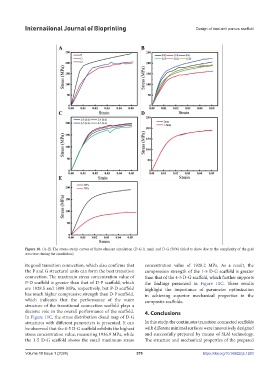Page 387 - IJB-10-1
P. 387
International Journal of Bioprinting Design of dual-unit porous scaffold
Figure 10. (A–E) The stress–strain curves of finite element simulation (D-G (1 mm) and D-G (50%) failed to show due to the complexity of the grid
structure during the simulation).
its good transition connection, which also confirms that concentration value of 1928.2 MPa. As a result, the
the P and G structural units can form the best transition compression strength of the 1-5 D-G scaffold is greater
connection. The maximum stress concentration value of than that of the 4-5 D-G scaffold, which further supports
P-D scaffold is greater than that of D-P scaffold, which the findings presented in Figure 10C. These results
are 1928.5 and 1888 MPa, respectively, but P-D scaffold highlight the importance of parameter optimization
has much higher compressive strength than D-P scaffold, in achieving superior mechanical properties in the
which indicates that the performance of the outer composite scaffolds.
structure of the transitional connection scaffold plays a
decisive role in the overall performance of the scaffold. 4. Conclusions
In Figure 11C, the stress distribution cloud map of D-G
structures with different parameters is presented. It can In this study, the continuous transition connected scaffolds
be observed that the 4-5 D-G scaffold exhibits the highest with different minimal surfaces were innovatively designed
stress concentration value, measuring 1936.9 MPa, while and successfully prepared by means of SLM technology.
the 1-5 D-G scaffold shows the small maximum stress The structure and mechanical properties of the prepared
Volume 10 Issue 1 (2024) 379 https://doi.org/10.36922/ijb.1263

